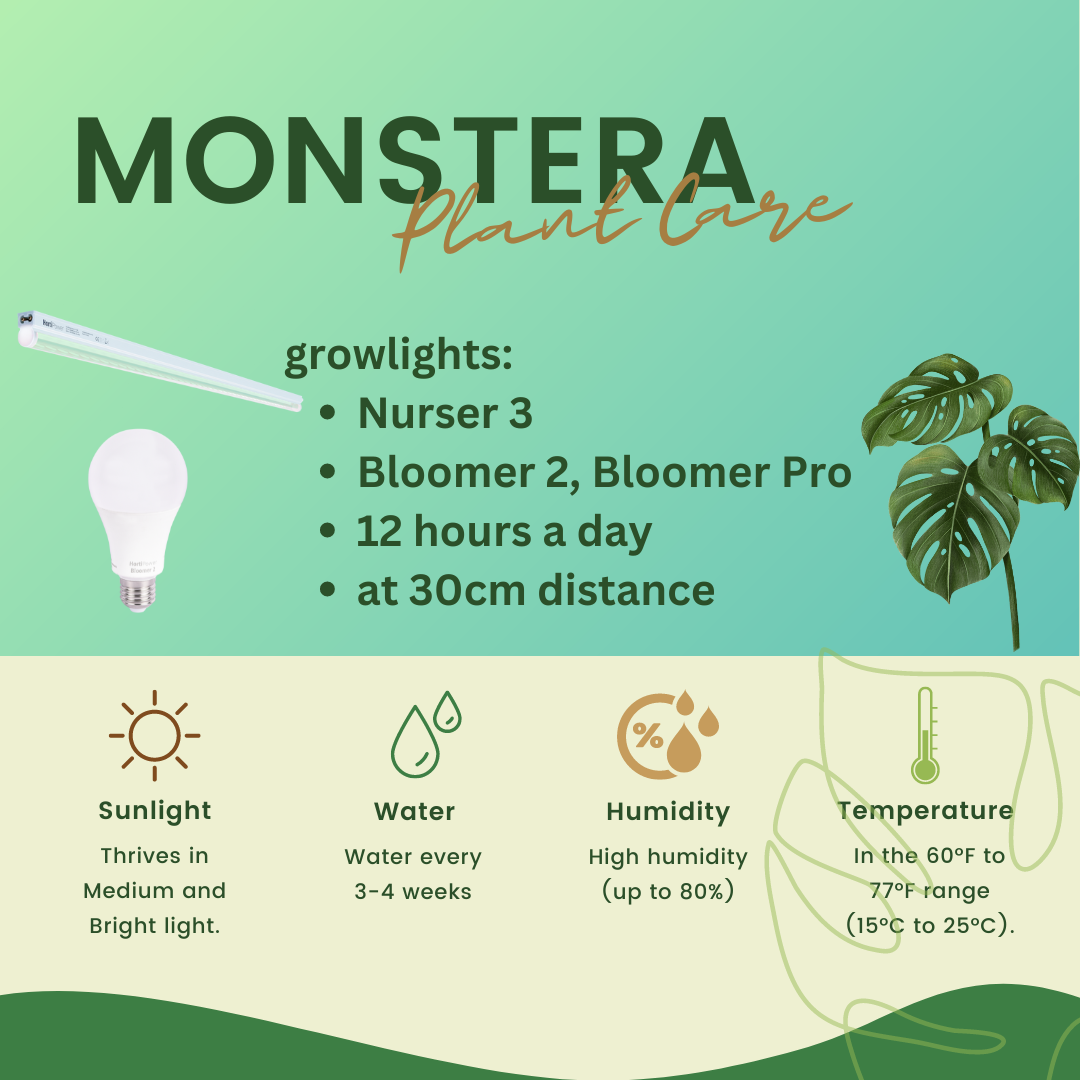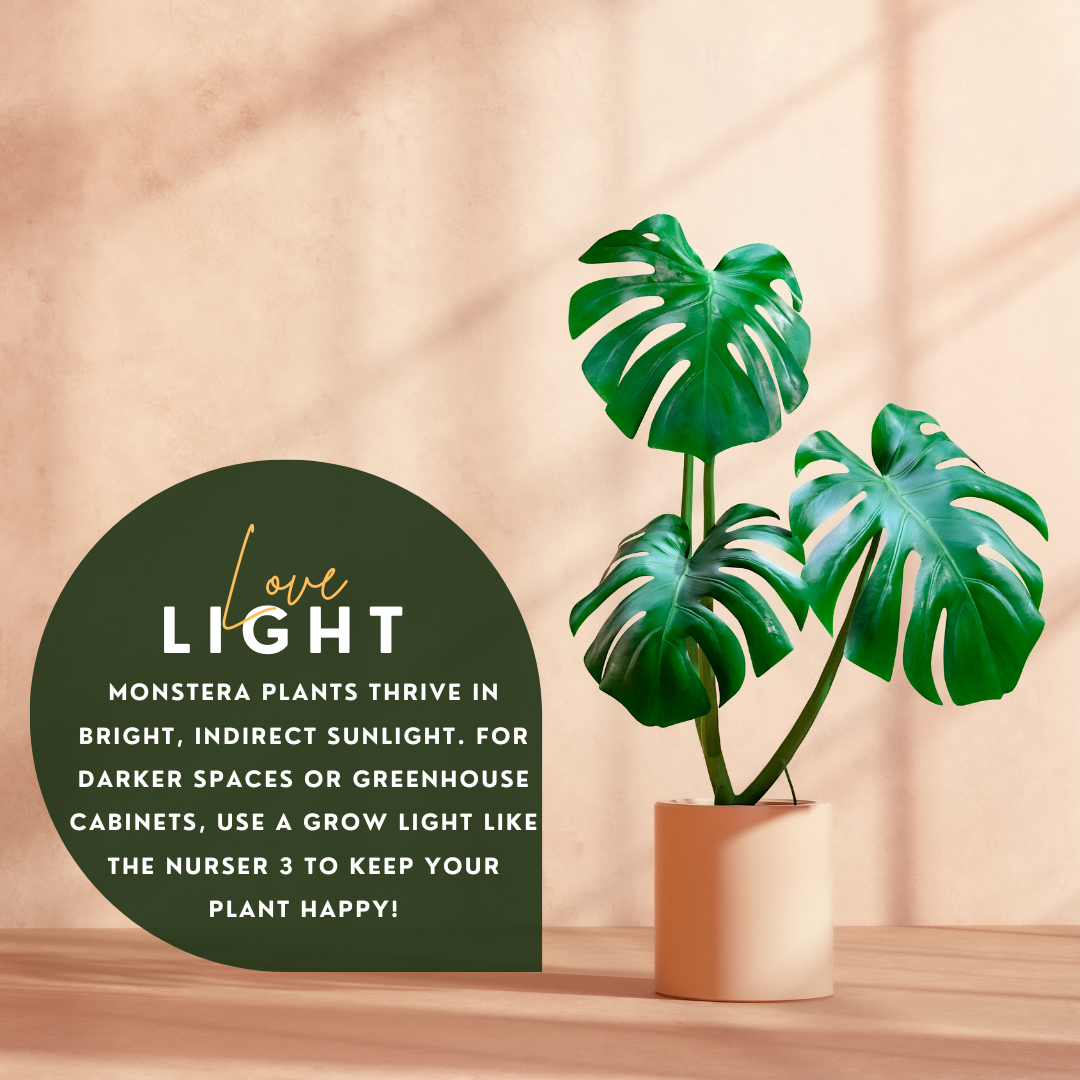The Monstera plant, also known as the Swiss cheese plant, is a popular houseplant known for its large leaves.
Edited by: AI, Jille Kuipers

Table of Contents
- 1. Introduction
- 2. Origin and Characteristics of Monstera
- 3. Popular Monstera Varieties
- 3.1 Monstera deliciosa
- 3.2 Monstera adansonii
- 3.3 Monstera obliqua
- 3.4 Monstera dubia
- 3.5 Monstera pinnatipartita
- 4. Monstera Care Tips
- 4.1 Location and Light
- 4.2 Tips for Using a Grow Light for Monstera:
- 4.3 Watering and Humidity
- 4.4 Fertilizing
- 4.5 Pruning and Shaping
- 4.6 Repotting and Soil Type
- 5. Propagation of Monstera
- 6. Common Pests and Diseases
- 7. Frequently Asked Questions About Monstera
- Q: How often should I water my Monstera plant?
- Q: Can I place my Monstera in direct sunlight?
- Q: How often should I fertilize my Monstera plant?
- Q: How do I propagate a Monstera plant?
- Q: What should I do if my Monstera leaves start turning yellow?
- Q: How big can a Monstera plant grow?
- Q: Can I grow Monstera plants outdoors?
- Q: What growlight should I get?

1. Introduction
The Monstera plant, also known as the Swiss cheese plant, is a popular and visually striking houseplant known for its large, fenestrated leaves. In this plant care guide, we will explore the origin, characteristics, and care requirements of Monstera plants to help you keep them healthy and thriving in your home.
2. Origin and Characteristics of Monstera
Monstera plants belong to the Araceae family and are native to the tropical rainforests of Central and South America. They are epiphytic climbers that can grow to impressive heights when provided with the right conditions. Monstera plants are characterized by their large, glossy, and deeply lobed leaves, which develop unique holes and splits as they mature.
3. Popular Monstera Varieties
3.1 Monstera deliciosa
Also known as the Swiss cheese plant, Monstera deliciosa is the most commonly cultivated variety. It features large, leathery leaves with distinct holes and splits.
3.2 Monstera adansonii
Monstera adansonii, or the Swiss cheese vine, has smaller leaves with more pronounced holes. It is a popular trailing variety often grown in hanging baskets.
3.3 Monstera obliqua
Monstera obliqua, commonly referred to as the "Swiss cheese plant on steroids," is a rare and highly sought-after variety known for its extremely perforated leaves.
3.4 Monstera dubia
Monstera dubia is a smaller variety with heart-shaped leaves and fewer holes. It is an excellent choice for smaller spaces or terrariums.
3.5 Monstera pinnatipartita
Monstera pinnatipartita is a unique variety with deeply divided leaves that resemble a palm or fern. It adds an exotic touch to any indoor space.
4. Monstera Care Tips
4.1 Location and Light
Place your Monstera plant in a bright, indirect light location. Avoid direct sunlight, as it can scorch the leaves. Monstera plants can tolerate lower light conditions but may grow slower.

4.2 Tips for Using a Grow Light for Monstera:
-
Choose a full-spectrum grow light, such as an LED grow light like the Bloomer 2, Bloomer Pro, or the Nurser 3 if you're growing Monstera in a greenhouse cabinet. These types of lights provide the necessary spectrum of light that Monstera plants require for optimal growth.
-
Position the grow light about 30-50 cm (12-20 inches) above the Monstera plant, depending on the strength of the lamp as well as the qty. This distance ensures that the plant receives adequate light without causing any light stress or burning. If you are using a linear light such as the Nurser 3 in a greenhouse cabinet it is recommended to have a spacing between the lights of about 20cm. This allows you to provide a very uniform and consistent light level on your monstera and it is likely to induce new leaf growth.
-
Allow the grow light to be turned on for about 12 hours per day. This is because the plant is from a region near the equator where daylight is approximately 12 hours. This duration provides the plant with the supplementary light it needs for healthy growth.
-
Monitor the plant's response to the grow light and adjust the distance and duration accordingly. If the plant shows signs of too much light, such as leaf burn, increase the distance between the light and the plant or decrease the number of hours the light is on. If new leaf growth is slow or new leaves are smaller than the existing leaves it it likely that the growth can be improved with better light to support the photosynthesis and a check on the nutrients.
Using a grow light can stimulate the growth and development of Monstera, especially during dark winter months or in locations with limited natural light. Monstera is known for its large, glossy leaves and can produce vibrant and long-lasting flowers under proper lighting conditions. With proper care and the right lighting, your Monstera helps you create an amazingly lush and green throughout the year.

4.3 Watering and Humidity
Water your Monstera plant when the top inch of soil feels dry. Ensure proper drainage and avoid overwatering, as it can lead to root rot. Monstera plants thrive in high humidity (some research suggests around 82% is ideal), and misting the leaves or using a humidifier can be beneficial.
4.4 Fertilizing
Feed your Monstera plant with a balanced, water-soluble fertilizer during the growing season (spring and summer) to promote healthy growth. Follow the instructions on the fertilizer packaging for proper dosage and frequency.
4.5 Pruning and Shaping
Prune your Monstera plant to control its size and shape. Remove any yellow or damaged leaves and trim leggy stems to encourage bushier growth. Wear gloves when pruning, as Monstera sap may irritate the skin.
4.6 Repotting and Soil Type
Repot your Monstera plant every one to two years or when it becomes root-bound. Use well-draining potting soil that retains some moisture but doesn't become waterlogged. A mix of peat moss, perlite, and orchid bark works well for Monstera plants.
Pro Tip for Planting:
To achieve better results when growing Monstera, a useful tip is to use a specific soil distribution in the pot. By filling the bottom half of the pot with fine soil and the top half with coarse soil, you can optimize plant growth.
The fine soil at the bottom provides sufficient moisture to the plant's roots, ensuring they stay well-hydrated. Its fine texture allows water to be absorbed more easily by the soil, facilitating moisture retention.
On the other hand, the coarse soil in the top half of the pot creates a more airy environment around the roots. This prevents the soil from becoming too compact, avoiding suffocation of the roots. An airy root zone promotes oxygen circulation, keeping the roots healthy.
By combining fine and coarse soil, you can achieve an optimal balance between moisture retention and airflow. This results in healthier and stronger plants that thrive and grow better.

Image from the report Zone-substraten: een nieuw substraatconcept voor de potplantenteelt by Fytagoras
5. Propagation of Monstera
5.1 Propagation by Stem Cuttings
Monstera plants can be propagated through stem cuttings. Select a healthy stem with at least one node and aerial root. Place the cutting in water or moist soil until roots develop, then transfer it to a pot.
5.2 Propagation by Air Layering
Air layering is another method for propagating Monstera plants. Make a small incision on a stem, wrap it with moist sphagnum moss, and cover it with plastic. Once roots form, cut below the rooting area and plant it in a pot.
5.3 Propagation by Seed
Monstera plants can also be propagated from seeds, although this method is less common and requires more time and patience. Sow fresh Monstera seeds in a well-draining seed-starting mix and keep them warm and consistently moist until germination occurs.
6. Common Pests and Diseases
Monstera plants are generally hardy, but they can be susceptible to certain pests and diseases. Common pests include spider mites, mealybugs, and aphids, which can be treated with insecticidal soap or neem oil. Diseases such as root rot and fungal infections can be prevented by providing proper watering and good airflow around the plant.
7. Frequently Asked Questions About Monstera
Q: How often should I water my Monstera plant?
A: Water your Monstera when the top inch of soil feels dry. Avoid overwatering.
Q: Can I place my Monstera in direct sunlight?
A: Monstera plants prefer bright, indirect light. Direct sunlight can scorch the leaves.
Q: How often should I fertilize my Monstera plant?
A: Fertilize your Monstera plant with a balanced fertilizer during the growing season (spring and summer), following the instructions on the packaging.
Q: How do I propagate a Monstera plant?
A: Monstera plants can be propagated through stem cuttings, air layering, or seeds.
Q: What should I do if my Monstera leaves start turning yellow?
A: Yellowing leaves can be a sign of overwatering or nutrient deficiencies. Adjust your watering routine and consider fertilizing if needed.
Q: How big can a Monstera plant grow?
A: Monstera plants can grow several feet tall, some people love to grow them from floor to their ceiling, depending on the variety and growing conditions.
Q: Can I grow Monstera plants outdoors?
A: Monstera plants thrive in warm, humid environments. They can be grown outdoors in tropical or subtropical regions.
Q: What growlight should I get?
A: For an individual plant in a dark corner you can get the Bloomer 2 or Bloomer Pro. If you're growing them in an indoor greenhouse cabinet you could use linear lights that are optimised for plant growth such as the Nurser 3.
Remember that each Monstera plant is unique, and individual care requirements may vary. By providing the right conditions of light, water, humidity, and regular maintenance, you can enjoy the beauty of these impressive plants in your home.

